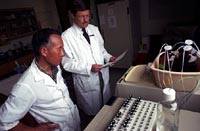In all types of Porphyria there are striking increases in porphyrins and/or porphyrin precursors when these conditions are symptomatic. However, even in Porphyrias that are inherited in an autosomal dominant pattern, there may be no such increases in many family members who carry the abnormal gene. Therefore, tests in addition to those useful in the presence of symptoms must be considered in patients with latent or subclinical disease.

Before deciding which tests are appropriate for asymptomatic family members, the diagnosis of Porphyria should be firmly established in the propositus (index case) or another individual in the family with a history of Porphyria. Results of previous testing in the propositus should be reviewed. It may be necessary to retest either the propositus or another family member with confirmed Porphyria before undertaking screening of family members. DNA testing is ideal for detecting carriers of a known mutation in a particular enzyme, but requires that the mutation first be fully characterized in the propositus.
Porphyrias seldom become completely latent (such that all levels of porphyrins and porphyrin precursors become normal) within a short period of time. However, it does become more difficult to rule out Porphyria if testing is delayed until after there is resolution of symptoms. If it is clinically important to exclude subclinical Porphyria in a patient with past suggestive symptoms, and if definitive testing was not conducted near the time of symptoms, a specialist physician and laboratory should be consulted to advise on the choice and interpretation of laboratory tests.